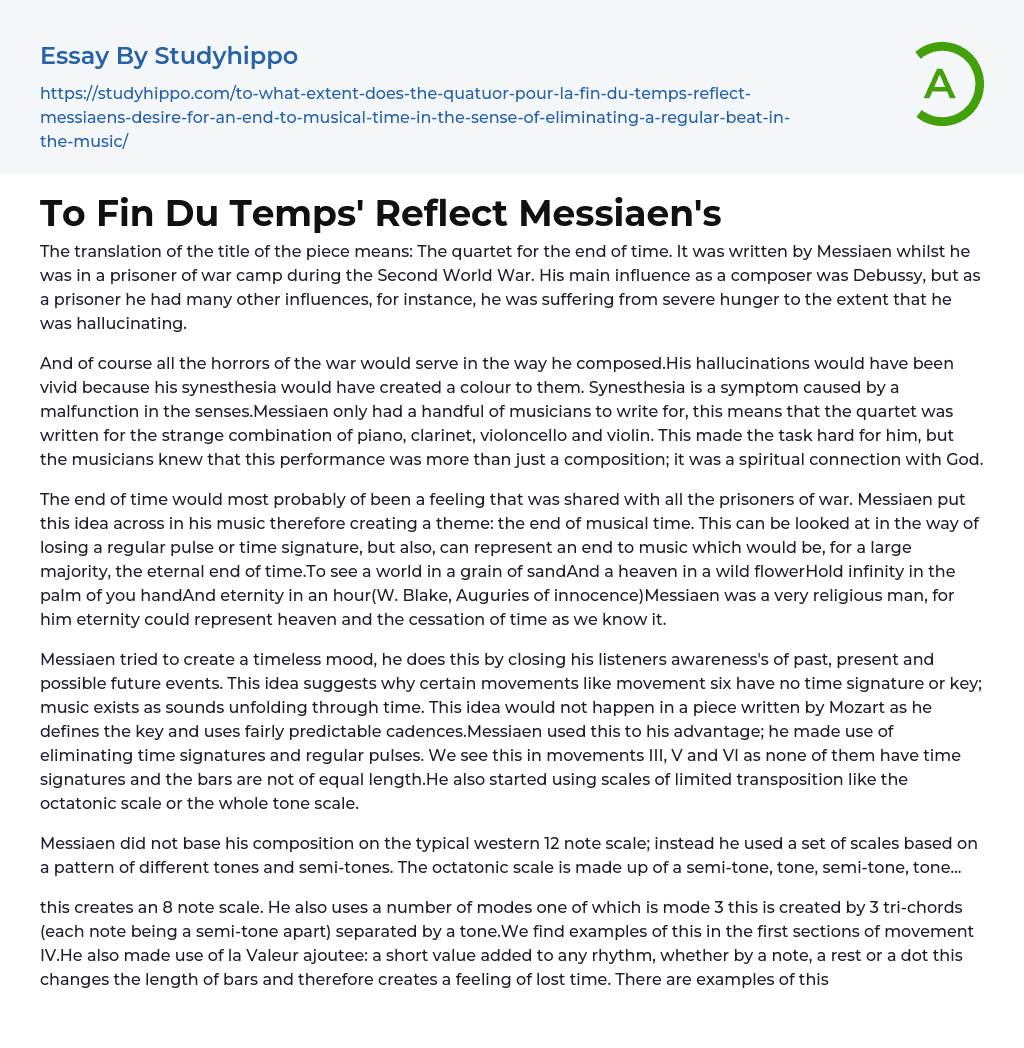Messiaen, while a prisoner of war during World War II, composed "The quartet for the end of time", which was heavily influenced by his experiences in captivity. Although Debussy had previously been Messiaen's primary inspiration as a composer, he drew upon various other factors such as extreme hunger resulting in hallucinations.
Messiaen's incorporation of the horrors of war into his compositions was amplified by his synesthesia, which evoked vivid colors in his hallucinations due to a sensory malfunction. He wrote the quartet for an unconventional set of instruments including piano, clarinet, violoncello, and violin - a challenge given the limited number of musicians available. Nonetheless, the performers recognized that playing this piece was not just about music but also meant establishing a spiritual connection with God.
Messia
...en's music conveyed the idea of the end of time, a feeling likely shared by all prisoners of war. This created the theme of the end of musical time, which could signify losing a regular pulse, as well as symbolizing the eternal end of music for many. As William Blake wrote, "To see a world in a grain of sand and a heaven in a wild flower, hold infinity in the palm of your hand and eternity in an hour" (Auguries of Innocence). Messiaen, a deeply religious man, viewed eternity as representing heaven and the cessation of time as we know it.
Seeking to create an ageless ambience, Messiaen sought to exclude his audience's awareness of past, present, and future events. This approach is evident in movement six, which lacks a specific time signature or key; the music merely exists as a progression of sounds over time. In contrast, Mozart's composition
have defined keys and predictable cadences. Messiaen leveraged this contrast by forsaking time signatures and regular pulses, as seen in movements III, V, and VI, whose bars vary in length and lack time signatures. He also employed limited-transposition scales such as the whole-tone scale and octatonic scale to further achieve his goals.
Instead of relying on the standard western 12 note scale, Messiaen incorporated a unique set of scales based on a particular sequence of semi-tones and tones. Specifically, he utilized the octatonic scale, which is composed of a repeating pattern of semi-tone, tone, semi-tone, tone...
In his composition, the artist devised an octave scale and incorporated various modes, including mode 3. Mode 3 is produced by three tri-chords, with each note separated by a semi-tone and separated by a tone. Illustrations of this can be found in the initial segment of movement IV. Additionally, he applied la Valeur ajoutee, which involves adding a short value to a rhythm through a note, rest, or dot, resulting in lengthened bars and generating a notion of time loss. Evidence of this technique can be observed in the first two bars of movement VI.
Modifying a normal time signature by adding a small note or rest, such as a semiquaver note or rest, or making a quaver dotted, can alter the time signature and cause it to feel off-beat. Incorporating these modifications in a bar can result in the entire bar losing its sense of time. This phenomenon is demonstrated in Movement VI bars 1, 10, and 11. Removing these notes or rests from the bar would restore it back to its original 4-4 beat.
In his music, Messiaen implements augmented
or diminished rhythms. This involves altering the length of notes to produce a second motif that resembles the original in terms of rhythm, but is shorter in duration, thereby creating a sense of time slowing down. Movement III features numerous instances of this approach, particularly between bars 25 and 27. To inspire a feeling of timelessness, Messiaen employs non-retrograde rhythms, which maintain the same order of note value when read from left to right or right to left. Movement VI exemplifies this technique between [F] and [G]. Messiaen also incorporates an independent pedal note, which persists endlessly without adhering to the rhythms surrounding it. The first movement incorporates this element through a 17 chord ostinato.
The concept of the end of time is depicted throughout the piece, with movements I, V, and VIII standing out for their emphasis on eternity and timelessness. Composer Messiaen wrote eight movements, symbolizing the days of the week with six representing the creation of the world and the seventh as a day of rest. The eighth movement represents judgement day and the concept of everlasting light and eternal peace. This concept was inspired by Messiaen's personal preference. How does this composition create this theme? Describe the function of each element.
- Business Law essays
- Contract essays
- Consumer Protection essays
- Property essays
- Ownership essays
- Agreement essays
- Common Law essays
- Contract Law essays
- Justice essays
- Security essays
- Tort Law essays
- United States Constitution essays
- Crime essays
- Lawsuit essays
- Treaty essays
- Family Law essays
- Marijuana Legalization essays
- Constitution essays
- War on Drugs essays
- Court essays
- Jury essays
- Police essays
- Protection essays
- Community Policing essays
- Criminal Law essays
- Judge essays
- Lawyer essays
- Employment Law essays
- Copyright Infringement essays
- Injustice essays
- Intellectual Property essays
- Breach Of Contract essays
- Jurisprudence essays
- Social Injustice essays
- Juvenile Justice essays
- Internet Privacy essays
- Cyber Security essays
- Bill Of Rights essays
- Civil Liberties essays
- First Amendment To The United States Constitution essays
- Fourth Amendment To The United States Constitution essays
- Second amendment essays
- Animal Cruelty essays
- Law Enforcement essays
- Juvenile Justice System essays
- Surveillance essays
- Forensic Science essays
- Crime Prevention essays
- Criminal Justice essays
- Criminology essays




